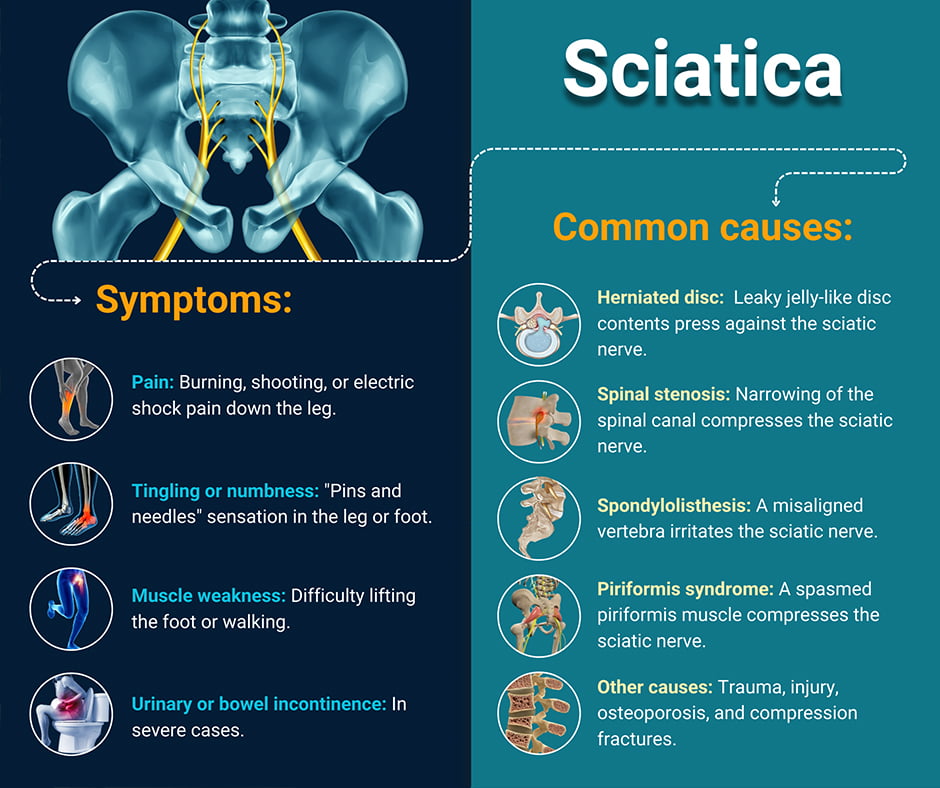Pain and tingling from your lower back to your legs and feet are symptoms of sciatica. You may feel some or all of these symptoms. No matter where you feel the pain, having it treated promptly eliminates the discomfort while treating the cause of your sciatica. To recapture a pain-free existence, get in touch with New York pain management, a first-class facility with nationally recognized sciatica doctors in New York City.
What Is Sciatica?
Sciatica (also known as lumbar radiculopathy) is a medical condition that affects your sciatic nerve. This large nerve runs from your lower back to your hips, buttocks, and on either side of your legs. The sciatic nerve runs all the way down to the soles of your feet. When the nerve is damaged or compressed, you feel a stabbing, shooting, or burning pain— as well as tingling, numbness, and weakness— anywhere in your lower back and hip region to the backs of your legs down to your feet and toes.
Sciatica is more common among people between the ages of 20 and 60. It usually affects only one side of your body. Any movement, including sneezing or coughing, can aggravate your pain. To get complete sciatica pain relief in NYC, a qualified pain doctor at the pain relief center needs to perform a complete medical check-up before suggesting sciatica treatments.
What Causes Sciatica?
Sciatica disease is typically caused by irritation of the root of the lower lumbar and lumbosacral spine.
Other sciatica causes include:
- Lumbar spinal stenosis
- Spondylolisthesis
- Degenerative disc disease
- Muscle spasm
- Pregnancy
Sciatica issues can be triggered by several problems that involve your spine. It might affect the nerves running along your back.
What Are the Risk Factors for Sciatica?
About 40 percent of Americans experience sciatica in their lifetime. Age is a major risk factor. As you grow older, your body, especially your spine, changes, and it can pinch the nerve.
Other risk factors include:

- Degenerative disc disease is a medical disorder caused by the wear and tear of your spine over the years. This wear-and-tear can result in injuring or impinging your sciatic nerve.
- Obesity, along with a sedentary lifestyle, contributes toward the bones in your back losing flexibility and becoming stiff. The extra weight may cause pressure on your sciatic nerve.
- Untreated diabetes, a result of obesity, causes a condition called diabetic neuropathy. High blood sugar damages the nerves in your extremities, especially your feet and toes.
- Desk jobs and truck driving can adversely harm your spine from the long hours of sitting in one place.
- Jobs that require heavy lifting or twisting your spine can also create problems that lead to sciatica. People complaining of acute or chronic lower back pain or hip pain have a high chance of getting exposed to sciatica disease.
What Are the Symptoms of Sciatica?
Sciatica pain treatment depends on the root cause of the sciatic nerve damage. All of these medical conditions can cause undue pressure on your sciatic nerve. Pressure leads to the painful sciatica symptoms you’re experiencing, such as:
- A herniated disc in your spine. Discs have jelly-like insides with a harder shell that weakens with time. If the shell cracks or ruptures, the contents spill out and press against your sciatic nerve.
- Spinal stenosis. This is a disorder that narrows the spinal canal, compressing the nerve roots and spinal cord. The wear and tear of your spine are usually associated with osteoarthritis.
- Spondylolisthesis. This medical disorder affects your lower back when a vertebra slips and becomes misaligned with your spine. It ends up narrowing the exit of the sciatic nerve, irritating it in the process.
- Piriformis syndrome. The piriformis muscle is found in the lower part of your spine, hips, and buttocks. When the muscle develops spasms, it can compress the sciatic nerve.
Other related medical reasons for lumbar radiculopathy may include a direct impact force from a car accident, a sports injury, or falling downstairs. Osteoporosis, a weakening of your bones, can create compression fractures in your spine.

Diagnosis for Sciatica Pain Relief
The diagnosis starts with the examination of your full medical history. It includes an investigation of the following factors:
- Whether you have had any recent injuries
- The location of your pain
- Pain level
Your top-rated sciatica surgeon will also need to know what makes the condition better, what makes it worse, and how and when it started. The next step is a physical examination, which entails testing your muscles, reflexes, and strength. You might also be asked to perform some stretching and moving exercises. It will help identify the activities that cause more pain.
To determine the cause of your pain, a sciatica specialist in NYC performs imaging tests. The most common tests used to come up with a diagnosis are:
- MRIs
- CT scans
- Spinal X-rays (regular X-rays are not able to provide a complete view of sciatic nerve damage)
Your healthcare provider can also order a CT myelogram. A sciatica doctor will inject a special dye into your spine to help create clearer pictures of your nerves and spinal cord to perform this test.
Are There Any Non-Invasive Treatments for Sciatica?
Sciatica treatment starts with a complete physical by the top-rated pain doctors in New York. You may be asked to walk on your toes or heels, rise from a squatting position, or lie on your back and lift your legs one by one during the examination. All these exercises, along with tests like an x-ray, MRI, CT scan, or electromyography, help your pain management doctor develop a treatment plan.
Several non-invasive treatments relieve sciatica pain. The proven procedures offered by Pain Management NYC include:
What Are the Minimally Invasive Treatment Options for Sciatica?
For severe pain that doesn’t respond to non-invasive treatments, your Manhattan sciatica treatment doctor may suggest minimally invasive surgery as the best option. These procedures are safe and fast, with proven consistent results. Pain Management provides a standard of care that’s among the best in the world. These minimally invasive procedures include:
Can I Treat Sciatica at Home?
Sciatica typically resolves on its own within a few weeks. It is recommended to avoid prolonged bed rest, as it can potentially exacerbate your sciatic nerve pain. Mild sciatica cases may be treated with self-care and home remedies.
Doing stretching and strengthening exercises can help support the lumbar spine, improve range of motion and flexibility, and decrease the pressure on the sciatic nerve. Applying hot and cold compresses to the affected area can help reduce muscle spasms, boost blood flow, and accelerate healing. The correct sitting position is also an important aspect of sciatica pain relief.
For chronic sciatica symptoms, non-steroidal anti-inflammatory drugs can be used. You can visit our medical center for meticulously crafted medical advice on what home remedies to use for reducing your specific symptoms. Our best-in-class sciatica specialist can also prescribe special clinic products for relieving your chronic pain.
How Can I Prevent Sciatica Pain?
Because sciatica can have various causes, it can be quite hard to prevent. Managing weight, maintaining proper back muscle tone, and abstaining from smoking and prolonged periods of sitting are common recommendations for sciatic pain prevention.
Chiropractic care and physical therapy are also essential to avoid recurrent sciatic episodes. Your physical therapist can offer you a treatment plan aimed at improving your posture and range of movement, thus reducing sciatica symptoms further and helping you avoid any recurrences going forward.
Whether you require surgery or a pain-killing injection, you’re treated with care and respect from the first moment you enter the facility. Sciatica is a condition that can be treated. Do not waste your time searching for a “sciatica doctor near me,” Start by contacting us to set up a consultation.

Leon Reyfman, MD, is a top-rated, best-in-class interventional pain management doctor. He is a nationally recognized pain relief specialist and is among the top pain care doctors in New York City and the country. He is an award-winning expert and contributor to prominent media outlets.
Dr. Leon Reyfman has been recognized for his thoughtful, thorough, modern approach to treating chronic pain. He has been named a “top pain management doctor in New York” and one of “America’s Top Doctors™” for advanced sports injury treatments. Among other accolades, he was voted by peers as a “Castle Connolly Top Doctors™” and “New York Super Doctors™”. Dr. Leon Reyfman was a part of the medical team at the 2016 Summer Olympic Games in Rio de Janeiro, Brazil.
